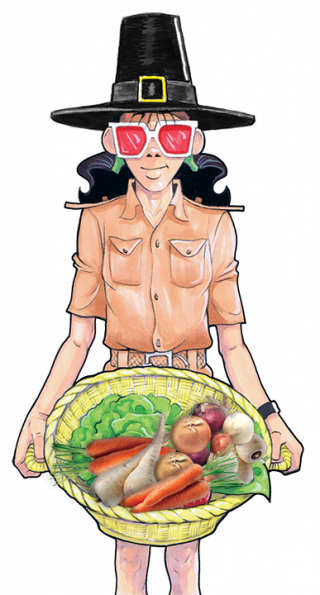The temperatures are dropping; we are nearing the end of the Fall harvest season. Have you been enjoying those fruits and vegetables especially associated with the final harvest before Winter? Those items include the cruciferous family of vegetables like cabbage, cauliflower, turnips, rutabagas, sweet potatoes and winter squash. Other foods at their best at this time of year include beets, Brussels sprouts, cranberries, grapes, leeks, mushrooms and, of course, pumpkins! The quintessential menu appears on Thanksgiving Day, when families partake of their Thanksgiving feast.
How closely does your holiday menu compare with that of the three day 1621 harvest celebration at Plymouth Colony now touted as the “First Thanksgiving?” Thanksgiving was not made an official holiday until 1863 when Abraham Lincoln designated the fourth Thursday of November to be a national holiday set aside to give thanks.
Little Miss HISTORY has traveled back into time to that first celebration at Plymouth Colony. Let’s take a peek…. Both the Wampanoag natives and the Plymouth colonists regularly ate wild turkey, but it was not specifically mentioned as present in that first feast. Edward Winslow, a signer of the Mayflower Compact and one of the leaders of Plymouth Colony, wrote about the first harvest feast. He says only that they brought back fowl which could indicate ducks and geese. The natives and colonists occasionally stuffed birds and fish with herbs, but in 1621 sugar and spices were expensive and may have been totally absent in Plymouth. Both sweet and white potatoes were rare and only available to the wealthy. Pumpkin was probably grown as a vegetable but not made into pie. Winslow mentions no meats, only fowl and venison. Mussels and eels were at their doorstep, but oysters were brought to them by the natives. The natives introduced the colonists to hard flint corn now known as Indian corn. Colonists combined their own dishes of porridge and pancakes with this corn. Produce from Plymouth gardens probably included dried and fresh parsnips, collards, carrots, parsley, turnips, spinach, cabbages, sage, thyme, marjoram and onions. There might have been dried wild blueberries, beans, grapes and nuts. Starting to sound more like a traditional Thanksgiving menu? Native cranberries, if available, were not made into sauce by boiling and adding sugar because this dish is not mentioned for another fifty years.
More than one hundred years later in 1779, Juliana Smith writes a letter to her cousin about plans for a New England Thanksgiving dinner. Meats on the menu include venison, turkey, pork, pigeon and goose. Her vegetable selections were creamed onions, cauliflower, potatoes and celery. A notable addition is a dessert selection of Indian pudding, plum pudding, mincemeat, apple and pumpkin pie. Cider appears to be the popular beverage. There would be no roast beef on the menu that year because the American Revolution dictated that all available beef must go to the armies fighting the battle for Independence. Throughout the nineteenth century, Thanksgiving week was also the harvest time for the merchants who would sell butter, lard, eggs, raisins and spices which would be needed for the feast. New Englanders enjoyed their family feast before settling in for the long winter season when weather and poor transportation conditions prevented them from moving freely about.
Nowadays, Thanksgiving Day remains a family celebration, but it also marks the beginning of a whole new holiday season. Unlike the colonists, we do not settle in for a long winter’s nap, but begin the frenzy of preparation for the Hanukkah, Christmas and New Year’s Day celebrations soon to come!
By Barbara Ann Mojica
Author of The Little Miss HISTORY Travels to…. children’s book series



Leave a Reply